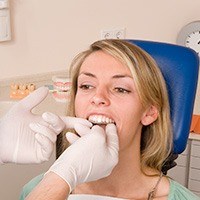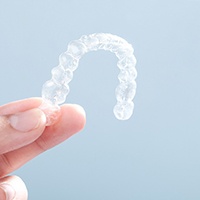Invisalign Straightening Smiles in Owings Mills
When you hear the word braces, you likely imagine big metal brackets attached to the fronts of teeth and shiny wires running through them. In fact, this image keeps many patients from taking the steps necessary to straighten their smiles. At Dolfield Dental of Owings Mills, we have a more cosmetic alternative to traditional metal bracket and wire braces – Invisalign orthodontics. This alignment tray orthodontic system allows patients to achieve perfectly aligned smiles without spending months or years with a mouthful of metal brackets and wires. Whether you’ve been putting off orthodontic care because you’re worried about your appearance or you just don’t have the time for frequent orthodontist appointments, Invisalign may be just what you’re looking for. If you’re ready to find out more about clear braces, call to schedule a treatment consultation in our state-of-the-art Owings Mills dental office today. Our skilled cosmetic dentist will examine your smile and help you create a plan to achieve a straight, healthy, beautiful smile.
How Invisalign works

Traditional braces shift teeth using wires to place pressure on brackets that are affixed to the fronts of teeth. Invisalign uses a series of clear, plastic alignment trays to move teeth into their ideal position. Each set of aligners represents your smile one step closer to the desired end result. You’ll simply wear the alignment trays for two weeks. Then, exchange them for the next set in the series. After about 12 months of treatment, patients have flawlessly aligned teeth, and all anyone will ever see is a beautiful smile.
Benefits of Invisalign

No orthodontic treatment is right for every patient, but for those who do decide Invisalign is right for them, there are numerous benefits, including:
- Look and feel great throughout treatment
- Save time with fewer, shorter office visits during treatment
- Reduce overall treatment times with plans that typically last eight to eighteen months
- Improve comfort with smooth Invisalign trays that avoid soft tissue irritation
- No hassle of changing your diet or oral hygiene routine
Understanding the Cost of Invisalign

The cost of Invisalign treatments varies dramatically from patient to patient because no two smiles are the same! The good news is that most plans are comparable in price to traditional braces, and many dental insurance providers now offer the same percentage of coverage for clear aligners. That means you won’t worry about paying more out of pocket for this cosmetically superior orthodontic solution! If you want to learn more about the cost of Invisalign leading up to your consultation, then read on.
Factors That Affect the Cost of Invisalign

In order to create your treatment plan and, in turn, determine how much your Invisalign treatment will cost, we need to determine:
- The extent of your misalignment
- The number of aligners needed
- If single-arch treatment is possible
- The overall length of treatment time
- If buttons, rubber bands, and other orthodontic accessories are needed
Keep in mind that there are also things that may come up down the line. For example, if you consistently don’t wear your aligners for 20-22 hours a day and completely fall off-track with your treatment plan, then we will need to make a new one.
Invisalign vs. Mail-Order Aligners: Which Costs More?

Over the years, there have been several mail-order aligner companies that have tried to compete with Invisalign. One of the biggest ones was Smile Direct Club™, which declared bankruptcy toward the end of 2023, leaving patients unsure of what to do or where to turn. That’s why it’s important not to simply go with the cheapest option. Instead, choose traditional braces, Invisalign, or another tried-and-true orthodontic treatment that has support from the ADA, that is administered by a licensed dental professional, and that is known for being reliable, effective, and safe.
Does Dental Insurance Cover Invisalign?

Patients are often surprised to hear that dental insurance companies sometimes cover a portion of the cost. Ultimately, it depends on the fine print on your dental plan! If it includes a once-in-a-lifetime orthodontic benefit, then upwards of 50% of the cost may be covered. We know that it can be hard to read through the seemingly endless pages and understand the unfamiliar jargon, which is why we’re also happy to help. In fact, we are happy to welcome several of the nation’s leading providers, including BlueCross BlueShield, and Delta Dental.
Options for Making Invisalign Affordable

If you don’t currently have dental insurance, you’ll be happy to know there is another way to make your dental care more affordable: our membership plan! In addition to covering regular dental exams and cleanings, you’ll enjoy considerable discounts on other services completed at our office when you join. Plus, you’ll never have to worry about the red tape that comes with dental insurance, like waiting periods and annual maximums.
Who should consider Invisalign?

Invisalign offers straighter smiles for more patients than ever before even those with serious alignment concerns like over, under, and crossbite. Invisalign is a great option for many patients, including those who:
- Don’t have time for frequent orthodontist appointments
- Want to maintain a professional image during their treatment
- Have allergies or sensitivities to metal
- Have sensitive teeth, gums, and oral structures
Invisalign FAQs
Who is Not Eligible for Invisalign?
We touched on above who should consider Invisalign, but is there anyone who isn’t a candidate for this discreet orthodontic treatment? The short answer is yes – at least initially. For example, if we find that you have a cavity, gum disease, or another serious oral health problem during your exam, then we will need to first focus on restoring your healthy smile. After all, decay-free teeth and infection-free gums are mandatory prior to getting braces. Ultimately, the best way to find out if you are or aren’t a candidate for Invisalign is by scheduling an appointment with our Owings Mills dental team.
How Long Does Invisalign Take?
If you’re looking for the average, it’s 12-18 months. With that said, your treatment timeline may fall outside of that. At your consultation, we will determine how many aligners are needed as well as how long you need to wear each aligner, which are two important factors when it comes to how much time you need to invest in Invisalign.
It’s also important that we mention here that you need to abide by all of the treatment guidelines in order to stay on-track with your treatment plan. That includes wearing your aligners for 20+ hours a day, switching to each new set on the correct days, and not using hot water to clean them.
Does Invisalign Hurt?
Although Invisalign doesn’t hurt, it is normal to experience some soreness throughout your treatment. Typically, this happens immediately following the transition to a new set of aligners, which is why patients are often encouraged to do so right before bed. You can also sip on cool water, avoid crunchy foods, and take OTC pain medication (as directed) to help alleviate any discomfort that arises.
What Happens After Invisalign?
At your “last” Invisalign appointment, we will take scans of your teeth, ensure you’re happy with the results, and send the impressions off so your retainer can be made. Since this usually takes a few weeks, we’ll have you continue to wear your current set of aligners in the meantime.
When your retainer arrives at our office, we will show you how to take care of it so it lasts as long as possible. We’ll also give you specific instructions on when you wear it, which is often 20-22 hours a day at first. Don’t worry – this is a temporary measure to help prevent orthodontic relapse (the phenomenon where teeth begin to shift out of position). Before long, you’ll get the green light to wear it only at night.
